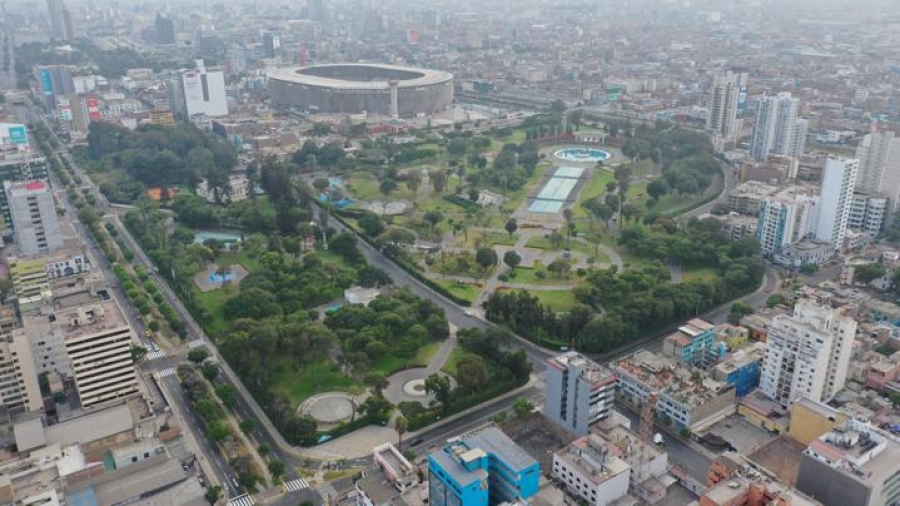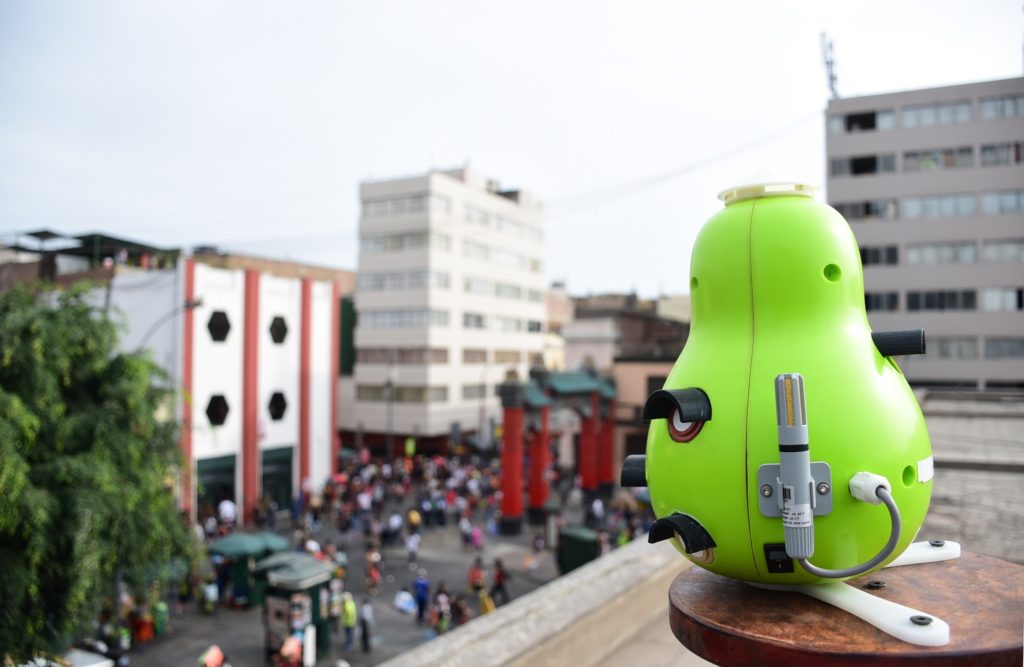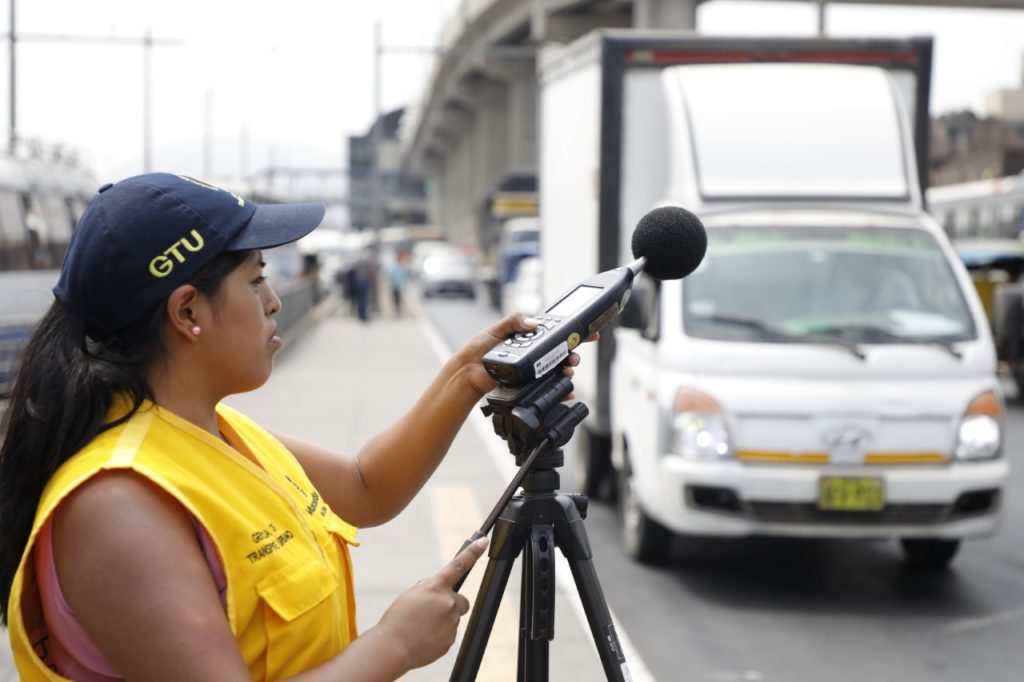Days after the team of the Division of Air Quality and Environmental Evaluations of the Metropolitan Municipality of Lima had the opportunity to share experiences with their peers from São Paulo and Mexico City, getting new knowledge, technical advice and ideas on improving air quality monitoring in Lima, their city ground to a halt.
It was 16 March, and Peruvian president Martín Vizcarra had triggered one of the earliest COVID-19 lockdowns in Latin America.
Over the next 20 days, the Metropolitan Municipality of Lima ເບິ່ງແລ້ວ as its new air quality monitoring and reporting system, based on a network of recently-installed low-cost sensors, recorded a drop in concentrations of fine particulate matter (PM2.5) in the city’s air. The monitoring system clocked that air pollution fell below 25 µg/m3 (24-hour mean), bringing levels in line with World Health Organization guidelines.

After 20 days of national quarantine, the Municipality of Lima’s air quality monitoring project registered a drop in concentrations of fine particulate pollution (PM2.5).
The qHAWAX air quality monitors — which also register noise levels, another common environmental health stressor in cities — feed into a digital platform that provides residents with real-time information on the state of the air they’re breathing in areas covered by the sensors, which, for now, are concentrated in the Cercado de Lima, the oldest district in Lima Province and a UNESCO heritage area.
The public could follow what was happening through an ແຜນທີ່ແບບໂຕ້ຕອບ, observing as the leaves marking out the monitored points in their city turned and stayed green; their color reflects current air quality based on the National Air Quality Index (INCA) — green for good air quality, yellow for moderate, orange for poor and red for hazardous.
It was a small boost to general awareness of the city administration’s goal in their vision to “make of Lima a city that is economically productive, socially and politically inclusive, and environmentally sustainable, preserving biodiversity, taking care of air and water, and the safety and physical health of citizens, especially it is scenarios of increasing vulnerability”, towards which beating air pollution is a pivotal step.
Lima joined the ແຄມເປນ BreatheLife with commitments that centered on improving air quality monitoring, a major part of a pledge it made as a C40 city. The city is deploying an ambitious air quality monitoring project, using sensors to make air quality information available to everyone in the city.
“Low-cost sensors are a very cost effective tool for air quality monitoring at a very local, micro level, for example, streets, parks, and neighborhoods, and so get a more accurate picture of exposure on the ground. They can complement reference stations, expanding coverage and making it possible for the public and decision makers to know in real time the state of the air in areas that beyond those covered by the reference stations. This helps to quickly implement preventive actions and generate public policies aimed at improving air quality and citizens’ health,” said Anderson Huayna, Chief of the Division of Air Quality and Environmental Evaluations of the Metropolitan Municipality of Lima.
The air quality monitoring network will also serve to keep air quality in the public eye, as Lima, a city of 9 million residents, along with others around the world, starts lifting restrictions after the lockdown. This year, the plan is to roll out a metropolitan network of 30 air quality modules like this, with the support of C40 Climate Leadership Group and the Union of Ibero-American Capital Cities (UCCI), the Ministry of Economy and Finance of Peru, and with technical support of the Union of Ibero-American Capital Cities (UCCI).
“The invisibility of the air generates indifference. The monitoring network aims to make the population aware of the problem and to give them the information they need to be able to participate in the solutions for a city with clean air as we recover from the pandemic”, said Ximena Giraldo, Manager of City Services and Environmental Management of the Municipality of Lima.
“The experiences derived from the implementation can be shared and used to improve decision making processes in a local, regional and national level, and with the ability to be replicated internationally,” she added.
Lessons from Mexico City and São Paolo
Learning how to do this in an optimal way was one objective the Lima Air Quality and Environmental Evaluations team had when they meet with São Paulo and ເມັກຊິໂກ air quality teams, building capacity and relationships with counterparts and colleagues in the two cities, which had success stories and lessons to share from long experience in battling air pollution.
From Mexico City, the team learned about a wide range of agencies involved in air quality control, from those involved in the technical aspects of monitoring to those concerned with mobility (such as its famed shared bicycle scheme, ECOBICI, and Metrobus), innovation and environment.
Mutual cooperation opportunities were generated, such as the exchange of information and technical advice on metropolitan ordinance project of emissions generated by the chimneys of restaurants and rotisseries, on equipment to verify vehicle emissions, and on sensor performance evaluation procedures for low-cost sensors to assess air quality.
São Paulo also offered relevant lessons and observations, particularly in making the air quality issue visible and accessible, connecting it with health outcomes by implementing a large network of air quality monitoring stations and a data analysis center, which reports hourly data and then transforms it into the Air Quality Index, whose values are reported on panels that are on public roads and visible to drivers.
Another interesting effort from São Paulo was the Health Surveillance Program, which surveys people who show up at health centers for cardiorespiratory disorders, with the objective of identifying the causes of the disease. By monitoring the health of these patients and the correlation of the disease with the air quality of the areas in which they live, it is possible to take forecasts or implement actions that minimize the impacts of air quality on health.
The knowledge acquired during the exchange of experiences, the team said, would allow the Municipality of Lima to effectively implement a reliable and sustainable air quality network.
“Learning from São Paulo’s and Mexico City’s implementation of air quality monitoring networks with low-cost sensors will allow the Metropolitan Municipal government of Lima to consider technical aspects to optimize the choice of sensors, location of monitoring points, procedures for evaluating the correct operation and performance in the field of the monitoring, and maintenance and good management of the web platform to transmit air quality information to the citizens of Metropolitan Lima in an educational way,” Anderson Huayna explained.
Dynamic ways to keep the public informed and engaged on clean air to “build back better”
Due to the COVID-19 pandemic, the Lima team is adapting to the new distancing reality with an online plan to use digital platforms for their awareness campaigns such as “Alto al Bocinazo (Stop the Honking)” and “Respira Limpio (Breathe Clean)”, whose main objective is to instruct drivers in the responsible use of the horn, and reduce vehicle emissions, respectively.
Other user-friendly ways to display air quality data to citizens that the team is planning to implement are “dynamic totems”, outdoor flat rectangular pillars fixed in areas of high footfall that display information on air quality and other essentials, such as weather information.
Built with materials resistant to weather conditions, it is designed to grab the attention of passers-by, giving them access to information in real-time, in a dynamic and understandable way.
Lima’s expanding air quality monitoring network, strengthened statistical and analytical methods and efforts to boost awareness of air quality among the public address key concerns noted by the World Bank about Peru in 2016, which included “a lack of informed and active public participation”, “little awareness about the seriousness of air pollution”, and, in cities that had functional air quality monitoring, the fact that relevant information was not widely distributed.
Encouraging more civil society engagement in decision-making is among the municipality’s objectives; its development and use of its various communication channels — its web platform, monitoring network, bulletins and dissemination through the Metropolitan Technical Group on Air Quality Management of the Metropolitan Environmental Commission, media, page web, social networks, among others — are part of the strategy designed to engage civil society in Lima’s clean air efforts.
“The efforts from the Metropolitan Municipality of Lima to increase transparency and public access to information, are fundamental to engage civil society in air quality improvement and to support decision-makers to make informed decisions to protect public health,” said Juan J, Castillo, air quality advisor from the Pan American Health Organization, which is actively engaged supporting Lima efforts.
The timing to engage a wider range of stakeholders than before could not, perhaps, be better, as “building back better” from the pandemic is on the minds of many around the world — from leaders and politicians to healthcare workers, business leaders and economists.
“We obviously can’t live in an eternal pandemic, nor do we want to live in social isolation; and for that reason this poses an opportunity to think about how we can reduce the emissions in a quicker way,” former Minister of Environment of Peru, Fabiola Muñoz, told a panel on air pollution and health recently, on World Environment Day.
“There are opportunities… in this pandemic context, but we have to be more creative and innovative than ever. Where the technology and the knowledge already exist, what we need, like we said at COP25 (the UN Climate Change Conference) last year, is to enlarge our ambition, increase our ambition, but also our sense of urgency,” she continued.
“We believe an inter-institutional effort is required to advance in public health protection, which is why we are supporting the government of Lima in the preparation of an Air Quality and Health Roadmap with the participation of city experts and the Ministries of Health and Environment,” said Magaly Guevara, PAHO national expert on environmental determinants of health.
Monitoring as a crucial element of meeting goals, commitments and aspirations
The growing air quality network is a cornerstone of bigger plans to improve air quality in Lima, which, along with 35 other cities around the world, pledged at a C40 World Mayor’s Summit in October 2019 to meet WHO air quality guidelines by 2030.

The new low-cost air quality monitors augment the city’s reference monitoring stations to widen the network and coverage, and also monitor noise levels.
To put it on a path towards meeting this goal, the city made more specific commitments, including to establish baseline emission levels (which has already been done) and setting ambitious reduction targets for air pollutants that meet or exceed national commitments— and to do these within two years.
Among other commitments, Lima has also pledged that before 2025, it would implement new substantive policies and programmes to address the top causes of air pollution emissions within its city and under its control.
“Some long-term results we hope our air quality monitoring efforts will lead to are the reinforcement of the efficiency of urban governance in the city, the strengthening of institutional, municipal and local and international ties, and the strengthening the capacities of local authorities to ensure the continuity of this air quality project,” Ximena Giraldo, said.
“We hope that civil society commitment will be strengthened when they notice that their voice is heard and translated into actions that can help improve the city’s air quality, which would consequently improve the quality of life of Lima citizens,” she added.
The municipal government has already put in place measures to encourage walking, cycling and public transport use, and has ແຜນການທີ່ຈະ launch incentives to take old cars and those in poor condition off the roads and integrate policies that regulate and reduce emissions from restaurants in famous culinary capital.
“We hope that in 2050, Lima will be a city with good air quality, that can provide all citizens with a good quality of life,” ກ່າວວ່າ Mayor of Lima, Jorge Muñoz, at the C40 Mayor’s conference in Copenhagen last October, linking the city’s growing population and transport demands with increased air pollution challenges, which had “jeopardized people’s health”.
The team at the Division of Air Quality and Environmental Evaluations of the Metropolitan Municipality of Lima hopes the air quality network and system continues to improve and contribute to Lima’s clean air plans and journey.
“We propose that the project has constant feedback through a series of indicators, such as the number of views of the platform, the awareness levels among the population or the directives and regulations derived from the information obtained from the monitoring network,” Anderson Huayna added.
In Lima, more than 1,600 premature deaths per year are attributable to air pollution, not to mention the cost in illness and suffering and lost work time.
“As we recover from this pandemic and continue our journey towards meeting our air quality commitments, it’s important to keep up the awareness that clean air is also essential to our health, standard of living, and the liveability of our city,” he concluded.
Read about the impact of the pandemic lockdown on air quality from the Municipality of Lima: CALIDAD DEL AIRE EN LIMA MEJORÓ DURANTE ESTADO DE EMERGENCIA, SEGÚN MONITOREO SOBRE PARTÍCULAS CONTAMINANTES
Read more about Lima’s environmental action here: Sistema Metropolitano de Información Ambiental
All photos are from the Municipal Government of Lima
